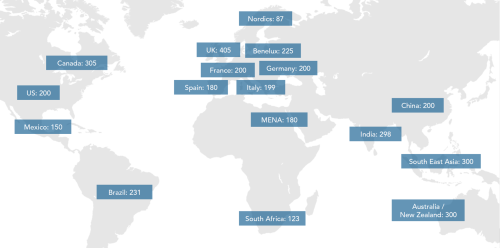
I recently ran across this: Global Staffing Trends 2017: The State of the Recruitment Industry. This little report from LinkedIn would be easy to dismiss, but I encourage you to take a look. It’s written for search/staffing firms. Not for corporate or in-house talent acquisition folks. So unless you’re a third-party staffing firm, not so interesting, right? Well, I’d encourage you to take a look.
I’ve had issues with LinkedIn’s research before, but this is a pretty straight-forward and easy to consume report. Won’t take you 10 minutes to read. But if you’re an in-house talent acquisition professional, you should read this. The trend information is pretty interesting.
Here are the top 4 takeaways as LinkedIn defines them:
Staffing firms expect to grow in 2017.
68% of staffing firms expect the size
of their firm to increase in 2017. They
intend to hire more recruiters, sourcers,
marketers, and coordinators during the
course of the next year.
The volume of placements will increase.
79% of staffing firms will see an increase in
the volume of candidates placed in 2017.
Despite this, an overwhelming number of
recruitment firms say that they still place
candidates in 2 months or less.
Budget goes to traditional tactics, but
branding tops investment wish list.
While nearly 50% of budget goes to
traditional sources, if given unlimited
funds, staffing firms would prioritize
business development, branding and
investing in better sourcing tools.
Social recruiting, candidate diversity,
and screening automation are the trends
defining the future of recruiting.
Using social and professional networks to
generate new business and recruit more diverse
candidates are on top of recruiters’ wish list.
Another prominent trend is the automation of
the screening and hiring process.
So why should you care?
Well, staffing firms think you’re going to be hiring more people in 2017 and that you’ll use their services more than you did in 2016. That means they think their businesses are going to grow year-over-year. They are staffing up to meet your growing demand for their services and that could mean they’ll have fewer experienced and proven professionals working on your searches. You may need to stay closer to those firms and the assignments you give them to ensure that your brand is being represented well in the talent marketplace.
While staffing firms think business will grow next year, they still expect to complete their assignments in two months or less. That’s interesting. Even if they do hire additional experienced staff, is it realistic to expect fast, great talent matches in the same period of time? Maybe. Maybe not.
Staffing firms would also really like to beef up their business development investments as a priority. So that means you’ll be called on more frequently by firms you’ve not engaged with previously. Gird yourselves for a sales and marketing onslaught.
And finally, understand what new kinds of technology your third-party recruiting firms are using to ensure that your brand is being cared for appropriately. Are you OK with the most of the steps in the funnel being automated? If you’re not, your search firm needs to know that. And if you are, how automated are those steps? And will they promise to eliminate the black hole in the search process?
If you use third-party recruiters, this report is interesting. How often do you get to see inside the budgets, investments, strategies and business planning of your providers? I think this information will help you manage these relationships and contracts, and help you create a win-win relationship with these mission critical partners. And make no mistake, any provider/partner/vendor who touches your talent is mission critical.








